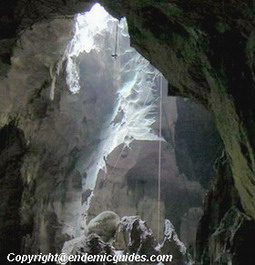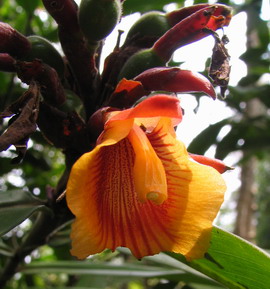|
Welcome To
GUA NIAH NP
PAGE - SARAWAK
|
Introduction
and History
Although it is one of Sarawak’s smallest national parks, it
is certainly one of the most important and unusual attractions
to visitors. What is most interesting about Niah is that one of
the main claims to fame is the birthplace of civilization in the
region. The oldest modern human remains in Southeast Asia along
with many other relics of prehistoric man were discovered about
40,000 years ago, making the park one of the most important
archaeological sites in the world.

The park has a size of 3,140 hectares of forest and
limestone karst areas. It was first gazetted as a National
Historic Monument in 1958 and on 23 November 1974 was gazetted
as National Park and open to public on 1 January 1975.
In 1958, a discovery was made which confirmed Niah as a site
of major archaeological significance. Led by Tom Harrison, he
and his team unearthed a skull at the West Mouth of the Great
Cave, which was estimated to be 40,000 years old. It was the
skull of a modern human (Homo sapiens). Apart from that, plenty
of human settlements in the area like tools, cooking utensils
and ornaments, made of bone, stone or clay were found. These
items found suggested that a long period of settlement reaching
back into the palaeolithic era (the earliest part of the Stone
Age).

Besides that, the Sungei Subis (Subis river) flows along the
park's western border. Not forgetting a large, almost vertical
limestone massif, Gunung Subis (Mount Subis), which rises from
the plain little above sea level and covers about 60% of the
area? The limestone was originally formed as a coral reef in
the Lower Miocene. Later it was uplifted and modified by
faulting and erosion.
There are
several hundred caves within the park boundaries. The two most
interesting and famous ones are Gua Niah (Niah Great Cave) and
Kain Hitam (Painted Cave). Both are immense archaeological
interest and have been declared as National Historical
Monuments.
The accessible way to the Caves is via a raised plank walk
that winds through lowland forest vibrant with birds and
butterflies. Today the Cave is home only to bats, swiftlets and
other specially adapted forms of life. However, a few locals
still venture into the dark interior to collect guano (bird and
bat droppings used as fertilizer) and bird's nest.
Apart from the Caves, visitors can explore several
kilometers of forest trails to feel the richness of tropical
rainforests, climb a 400m tall limestone ridge or visit an Iban
longhouse located near the Park boundary. Visitors can also rent
a boat or walk along the river from Park headquarters to Batu
Niah town.

FLORA AND
FAUNA
It is worth taking your time and walking quietly along the
way, as you may well see some of the park's wildlife. If you
leave the Great cave and return along the plank walk around
clouds intermingling, you can see half a million of swiftlets
are returning to their nests, whilst half a million bats fly out
to forage in the forest. This is one of Niah's most spectacular
sights which represent only a small niche in the earth complex
ecosystem. One of Niah's other notable sights is the unusual
number of luminous fungi that growth at dark night.

Colourful birds, squirrels, lizards, butterflies and all
manner of unusual insects and invertebrates are commonly seen.
Cave creature like Cave Spider, Cave Cockroaches, Cave Bats,
cave snake and frogs. If you are lucky, you may see monkeys,
flying lizards and the occasionally hornbill.
.
Continue Page 2 >>
|